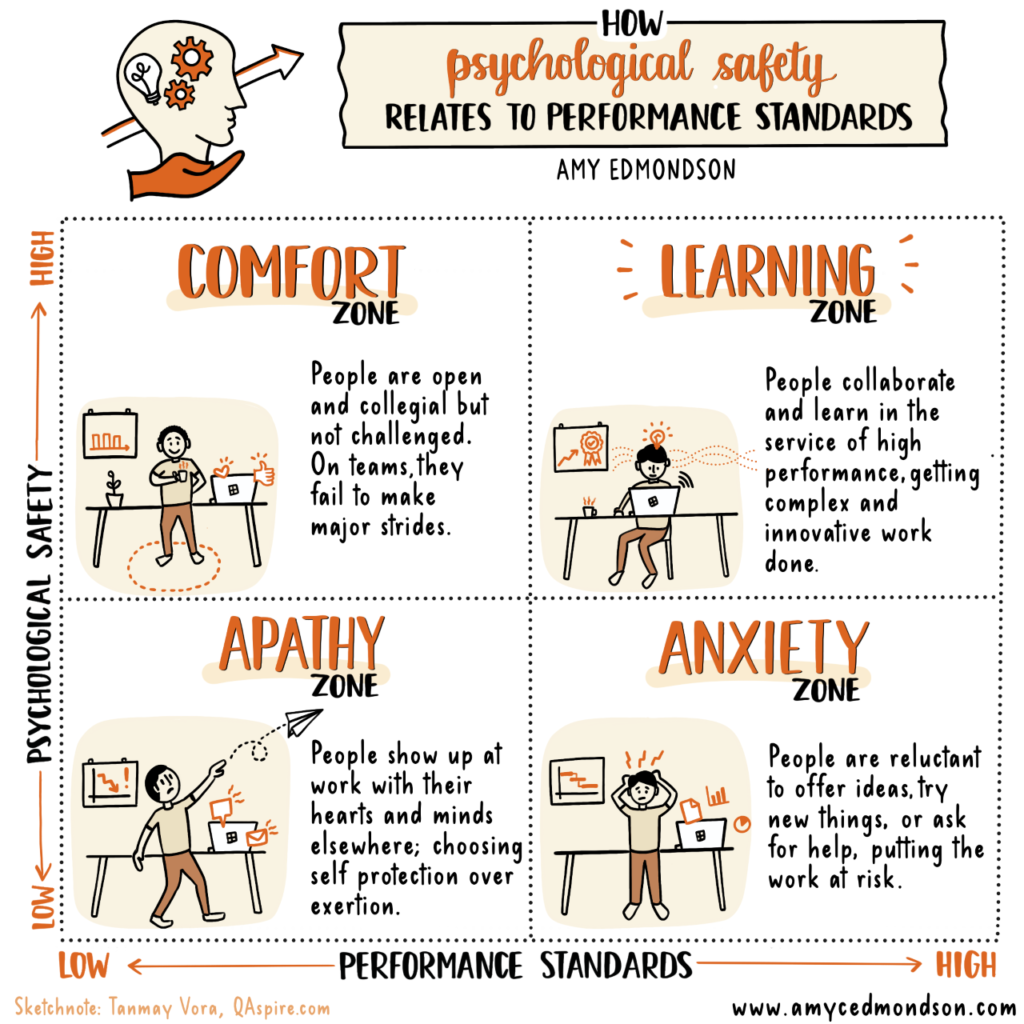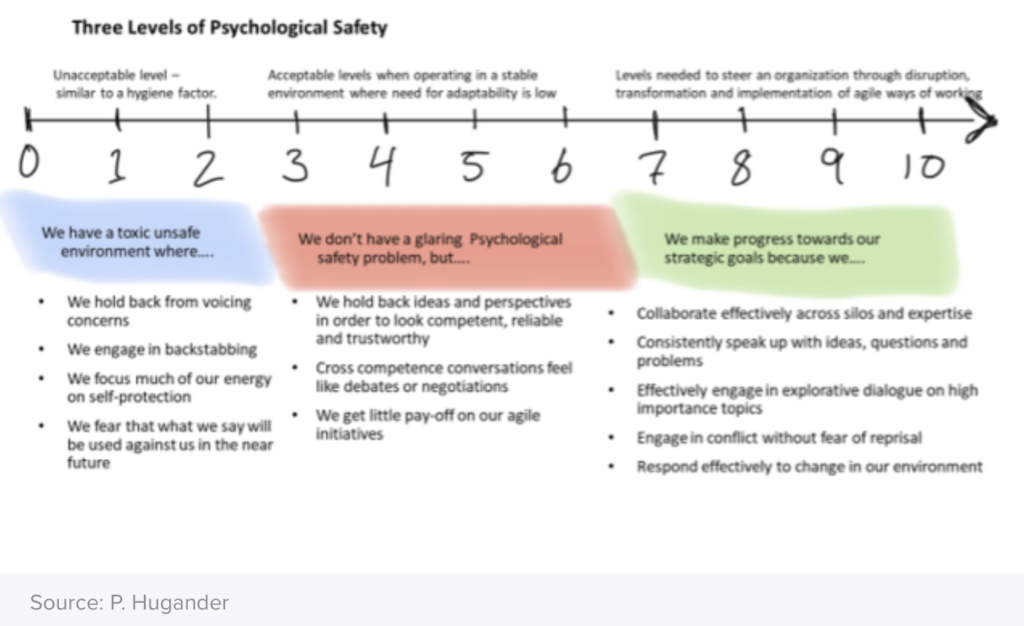Psychological safety has emerged as a cornerstone for fostering collaboration, learning, and excellence in today’s workplaces. Extensively researched by Dr Amy Edmondson, psychological safety is vital in any group setting where trust and collaboration directly impact outcomes. It is not just a cultural ideal, but a practical necessity.
What is Psychological Safety?
You might have read or heard more about psychological in the last few years, but what is it? In short, it is defined as a shared belief that a team environment is safe for interpersonal risk-taking. In practice, this means individuals feel confident to voice ideas, concerns, and mistakes without fear of retribution or ridicule. Edmondson describes it as “a sense of permission for candour” where contributions are valued and necessary for success.
The importance of psychological safety lies in its ability to create a “learning zone,” characterised by high levels of both psychological safety and performance standards. In such environments, teams continuously address challenges, solve problems, and innovate. This balance of interpersonal risk taking with measurable stretch is essential for individuals and organisations to achieve achieve success.

Research conducted by Google’s Aristotle Project reinforces this, showing that psychological safety is the single most important factor in determining team effectiveness. When individuals feel safe to take risks and be vulnerable, collective intelligence flourishes.
What Psychological Safety is Not
A common misconception is that psychological safety equates to being “nice” or avoiding difficult conversations. Timothy Clark emphasises that it is not freedom from conflict or discomfort. Instead, it demands respectful and candid dialogue aimed at improving performance and outcomes.
Psychological safety is also not a licence for complacency. Edmondson stresses it is not permission to slack off or over-share irrelevant details. Rather, it is about fostering meaningful, work-focused communication that drives collective excellence.
Additionally, psychological safety does not mean that every idea will be accepted or implemented. It is about creating a forum where ideas are considered without bias or fear of ridicule. Constructive criticism is welcomed as a pathway to improvement, not a deterrent to participation.
Lastly, psychological safety is not a goal in itself. Instead it’s a means to achieve higher objectives. Without a commitment to excellence, psychological safety risks devolving into a “comfort zone” where progress stagnates. Thus, achieving and maintaining psychological safety requires a dual focus on trust and performance.
What Do the Stages Look Like in Practice?
Timothy Clark’s framework outlines four progressive stages of psychological safety. These stages build upon each other, requiring consistent leadership and cultural reinforcement. For instance, a team transitioning to a new protocol must first establish inclusion safety before encouraging open dialogue about potential pitfalls (contributor safety) and later empowering members to suggest improvements (challenger safety).

Inclusion Safety: The foundation where individuals feel accepted and included within the team. This stage is essential for building trust and belonging.
Practical Example: A manager builds rapport with new team members and provides a comprehensive induction, ensuring they feel welcomed and valued from day one.
Learner Safety: At this stage, team members feel comfortable asking questions, experimenting, and admitting mistakes. It fosters curiosity and continuous improvement.
Practical Example: At the end of a team planning meeting, team members have the opportunity and space to clarify any information that wasn’t clear to them without judgment.
Contributor Safety: Here, individuals are empowered to use their skills and insights to contribute meaningfully to the team’s goals.
Practical Example: A project lead seeks input from team members aligned to different thinking styles and assigns tasks that align with each individual’s strengths.
Challenger Safety: The pinnacle stage where individuals feel confident to challenge the status quo, propose new ideas, and question decisions and processes without fear of retribution.
Practical Example: A company adopts open forums where employees can voice concerns or suggest changes to policies without repercussions.
How Psychological Safety Gets Derailed
Despite its benefits, psychological safety can be fragile and is often undermined by certain behaviours and systemic issues. For psychological safety to flourish, the first assumption leaders and team members must hold is that ‘everyone is working with their best intentions’.
Issues such as unresolved historical events, incongruence between leaders behaviours and communication, or the impact of prolonged stress on team members’ capacity and perspective, can all seem invisible or inconsequential until a snowball effect leads to more obvious dysfunction.
Some of the key derailers include:
Authoritarian Leadership: Leaders who dismiss input, can’t listen or foster an environment of fear, create an environment of interpersonal anxiety where members of the team hesitate to speak up.
Overlooking Maintenance: Psychological safety requires constant nurturing. A one-off training or initiative is insufficient; it demands ongoing feedback loops and recognising shifting human dynamics.
Cultural Misalignment: Without alignment between organisational values and practices, employees may perceive psychological safety initiatives as performative rather than genuine.
Micro-Managing: Excessive control over tasks and decision-making stifles employee autonomy and discourages open communication, eroding trust and psychological safety.
Lack of Accountability: When team members see no action taken on their concerns, trust in the system erodes. This undermines the willingness to speak up in the future.
Setting Up Systems and Ensuring Maintenance
Creating and sustaining psychological safety involves intentional strategies and continuous monitoring. Psychological safety is not a set and forget. So, it’s vital to first understand the organisation’s current starting point before applying approaches, and then be adaptable to changing environmental and team factors.
So how do you recognise the culture’s starting point? Amy Edmondson provides a simple rating scale and some of the typical behaviours that may be present.

If a culture’s score 1 – 3, there are possibly psychosocial hazards present and an in-depth investigation is needed. For cultures with scores between 3 – 6, on a daily basis the team may appear to function well enough but potential hazards are often hidden, constraining the team’s potential. Many organisations operate in this environment. A score between 7 – 10 reflects a healthy and productive culture. At this stage, regular input from all members of the team, to adapt and maintain the culture, creates an amplifying effect on the team’s potential.
To build and maintain a culture of psychological safety, it’s critical not fall into a top down approach. The more input people feel they have into how the team works, the greater their engagement and investment in the team and outcomes.
Establishing agreed team systems, through habits, rituals, standards of behaviour and processes, creates the foundations for psychological safety. Agreed ways of working allow each team member to play an active role in maintaining the team culture through social accountability. While leaders set the tone, their pivotal role is guiding the team and stepping in to address issues or key decisions.
Here are some practical steps to consider:
Leadership Development: Equip leaders with the skills to foster inclusivity, encourage open dialogue, and respond constructively to feedback.
Example: Development sessions to build self awareness and skills such as active listening and empathetic communication for all managers.
Structured Feedback Mechanisms: Establish regular forums where employees can share their thoughts without fear of retaliation. Google’s Aristotle Project underscores the value of such systems in creating high-performing teams.
Example: Implement anonymous digital surveys to gather employee insights on team dynamics, and take visible action on those insights.
Normalising Vulnerability: Leaders can model vulnerability by admitting their own mistakes and actively seeking input from their teams.
Example: A leader shares a personal learning experience during a team meeting to encourage openness.
Embedding Psychological Safety into Processes: From onboarding to performance reviews, align organisational processes with the principles of psychological safety. For instance, include psychological safety metrics in team assessments.
Example: Adding a “psychological safety score” to quarterly team evaluations.
Monitoring and Adjusting: Conduct regular assessments to gauge team dynamics and address emerging issues. Tools like anonymous surveys can provide insights into areas needing attention.
Example: Quarterly check-ins with teams to identify and discuss potential challenges to psychological safety.
Why it Matters Across All Industries and Organisations
Psychological safety is not confined to any single industry. Whether in tech, finance, education, creative arts, media or manufacturing, its principles are universally applicable. Teams that prioritise psychological safety consistently outperform those that do not.
For example, in arts and creative industries, where innovation is paramount, psychological safety allows employees to pitch unconventional ideas. In education, it encourages teachers to share effective teaching strategies without fear of criticism. In manufacturing, it ensures that safety concerns are raised promptly, preventing potential hazards.
Conclusion
Psychological safety is a dynamic, multi-faceted concept that underpins team performance and organisational success. By understanding what it is—and what it is not—organisations can implement the necessary cultural practices and systems to nurture this in their teams. From fostering inclusion to maintaining high standards of excellence, psychological safety enables teams to innovate, learn, and thrive in even the most demanding environments. It is not just a strategy; it is an ongoing commitment to creating workplaces where everyone’s voice matters.

